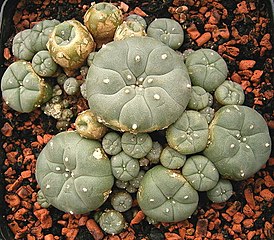Peyote
The peyote is a small, spineless cactus which contains psychoactive alkaloids, particularly mescaline. Known for its psychoactive properties when ingested, peyote has at least 5,500 years of entheogenic and medicinal use by indigenous North Americans.
The religious, ceremonial, and healing uses of peyote may date back over 2000 years.
Name
Peyote is a Spanish word derived from the Nahuatl peyōtl, meaning "caterpillar cocoon", from a root peyōni, "to glisten."
French botanist Charles Antoine Lemaire described the species as Echinocactus williamsii in 1845, but it was placed in the new genus Lophophora in 1894.
Range
Peyote is native to Mexico and southwestern Texas. It is found primarily in the Sierra Madre Occidental, the Chihuahuan Desert and in the states of Nayarit, Coahuila, Nuevo León, Tamaulipas, and San Luis Potosí among scrub.
It is primarily found at elevations of 100 to 1,500 m (330 to 4,920 ft) and exceptionally up to 1,900 m (6,200 ft) in the Chihuahuan desert, but is also present in the more mild climate of Tamaulipas. Its habitat is primarily in desert scrub, particularly thorn scrub in Tamaulipas. It is common on or near limestone hills.
Cultivation
Peyote is extremely slow growing. Cultivated specimens grow considerably faster, sometimes taking less than three years to go from seedling to mature flowering adult. More rapid growth can be achieved by grafting peyote onto mature San Pedro root stock. The top of the above-ground part of the cactus, the crown, consists of disc-shaped buttons. These are cut above the roots and sometimes dried.
When done properly, the top of the root forms a callus and the root does not rot. When poor harvesting techniques are used, however, the entire plant dies.
Currently in South Texas, peyote grows naturally but has been over-harvested, to the point that the state has listed it as an endangered species. Cultivation is an important conservation tool for this particular species. Promoting San Pedro as a Peyote substitute may act as an intervention to reduce Peyote consumption.
Psychoactive properties
When used for its psychoactive properties, common doses for pure mescaline range from roughly 200 to 400 mg. This translates to a dose of roughly 10 to 20 g of dried peyote buttons of average potency; however, potency varies considerably between samples, making it difficult to measure doses accurately without first extracting the mescaline. The concentration of mescaline is typically highest at the sides of the peyote button. The effects last about 10 to 12 hours.
Peyote is reported to trigger rich visual or auditory effects and spiritual or philosophical insights.
History of use
From earliest recorded time, peyote has been used by indigenous peoples, such as the Huichol of northern Mexico and by various Native American tribes, native to or relocated to the Southern Plains states of present-day Oklahoma and Texas. Its usage was also recorded among various Southwestern Athabaskan-language tribal groups.
The Tonkawa, the Mescalero, and Lipan Apache were the source or first practitioners of peyote religion in the regions north of present-day Mexico. They were also the principal group to introduce peyote to newly arrived migrants, such as the Comanche and Kiowa from the Northern Plains.
Modern era
Under the auspices of what came to be known as the Native American Church, in the 19th century, American Indians in more widespread regions to the north began to use peyote in religious practices, as part of a revival of native spirituality. Its members refer to peyote as "the sacred medicine," and use it to combat spiritual, physical, and other social ills.
Concerned about the drug's psychoactive effects, between the 1880s and 1930s, U.S. authorities attempted to ban Native American religious rituals involving peyote, including the Ghost Dance. Today the Native American Church is one among several religious organizations to use peyote as part of its religious practice. Some users claim the drug connects them to God.
Traditional Navajo belief or ceremonial practice did not mention the use of peyote before its introduction by the neighboring Utes. The Navajo Nation now has the most members of the Native American Church.
Religious use
Peyote is considered sacramental and sacred in the Native American Church, also known as Peyotism. It is used in rituals for "a closer understanding of the spiritual world" and to commune with spirits in order to receive power, guidance, reproof, and healing. To many followers, peyote itself is personified as "Peyote Spirit," considered to be either God's equivalent for the Indians to Jesus for mainstream Christians, or Jesus himself.
Peyote is consumed during an all-night healing ceremony inside a hogan, a traditional Navajo building, or a tipi. The ritual starts around 8 P.M Saturday, and includes prayer, singing, sacramental eating of peyote, water rites, and contemplation. It concludes with a communion breakfast on Sunday morning.
